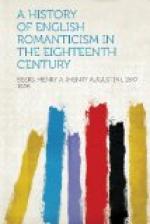It remains to add that romanticism is a word which faces in two directions. It is now opposed to realism, as it was once opposed to classicism. As, in one way, its freedom and lawlessness, its love of novelty, experiment, “strangeness added to beauty,” contrast with the classical respect for rules, models, formulae, precedents, conventions; so, in another way, its discontent with things as they are, its idealism, aspiration, mysticism contrast with the realist’s conscientious adherence to fact. “Ivanhoe” is one kind of romance; “The Marble Faun” is another.[20]
[1] Les definitions ne se posent pas a priori, si ce n’est peutetre en mathematiques. En histoire, c’est de l’etude patiente de is la realite qu’elles se degagent insensiblement. Si M. Deschanel ne nous a pas donne du romantisme la definition que nous reclamions tout a l’heure, c’est, a vrai dire, que son enseignement a pour objet de preparer cette definition meme. Nous la trouverons ou elle doit etre, a la fin du cours et non pas a debut.—F. Brunetiere: “Classiques et Romantiques, Etudes Critiques,” Tome III, p. 296.
[2] Was war aber dis romantische Schule in Deutschland? Sie war nichts anders als die Wiedererweckung der Poesie des Mittelalters, wie sie sich in dessen Liedern, Bild- und Bauwerken, in Kunst und Leben, manifestiert hatte.—Die romanticsche Schule (Cotta edition), p. 158.
[3] “The Romantic School” (Fleishman’s translation), p. 13.
[4] Un classique est tout artiste a l’ecole de qui nous pouvons nous mettre sans craindre que ses lecons on ses exemples nous fourvoient. Ou encore, c’est celui qui possede . . . des qualites dont l’imitation, si elle ne peut pas faire de bien, ne peut pas non plus faire de mal.—F. Brunetiere, “Etudes Critiques," Tome III, p. 300.
[5] Mr. Perry thinks that one of the first instances of the use of the word romantic is by the diarist Evelyn in 1654: “There is also, on the side of this horrid alp, a very romantic seat.”—English Literature in the Eighteenth Century, by Thomas Sergeant Perry, p. 148, note.
[6] “Romanticism,” Macmillan’s Magazine, Vol. XXXV.
[7] The Odyssey has been explained throughout in an allegorical sense. The episode of Circe, at least, lends itself obviously to such interpretation. Circe’s cup has become a metaphor for sensual intoxication, transforming men into beasts; Milton, in “Comus,” regards himself as Homer’s continuator, enforcing a lesson of temperance in Puritan times hardly more consciously than the old Ionian Greek in times which have no other record than his poem.
[8] “Racine et Shakespeare, Etudes en Romantisme” (1823), p. 32, ed. of Michel Levy Freres, 1954. Such would also seem to be the view maintained by M. Emile Deschanel, whose book “Le Romantisme des Classiques” (Paris, 1883) is reviewed by M. Brunetiere in an article already several times quoted. “Tous les classiques,” according to M. Deschanel—at least, so says his reviewer—“ont jadis commence par etre des romantiques.” And again: “Un romantique seraut tout simplement un classique en route pour parvenir; et, reciproquement, un classique ne serait de plus qu’un romantique arrive.”




